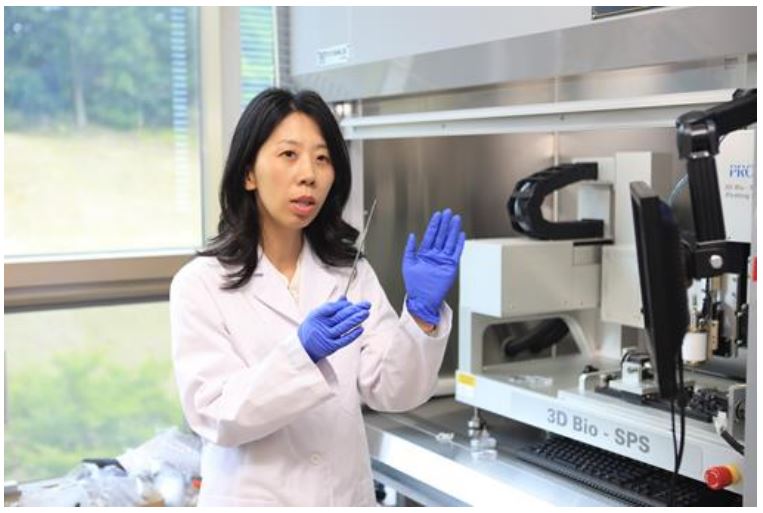
- Created2019.08.13
Development of Next-Generation Biodegradable Polymer Stent with Bio 3D Printing
-KIMM Develops Biodegradable Coronary Artery Stent-
-The World’s First Successful Preclinical Trials -
-Patient-customized Biodegradable Polymer Stent Significantly Lowers
Risk of Re-narrowing of Blood Vessels and Re-operation -
The Korea Institute of Machinery and Materials (KIMM, led by President Chun Hong Park) developed a technology to produce a next-generation biodegradable polymer stent with biodegradable materials instead of metal, and succeeded in the world’s first preclinical trials. The underlying bio 3D printing technology is able to make possible much faster patient-customized production, and the risk of reoperation will be significantly lowered as the stent is biodegradable within the human body.
Dr. Su-ah Park of Department of Nature-Inspired Nano Convergence Systems, Nano-Convergence Mechanical Systems Research Division of KIMM and her research team successfully developed a biodegradable polymer stent using bio 3D 2 printing technology by coating polymer materials that are highly suitable for human body with heparin*
* Heparin: Exists in blood to prevent coagulation. Used to prevent coagulation and blood clot after operations.A stent is a mesh-typed tube inserted to prevent diseases including angina, which occurs when the walls of the arteries become narrow. It expands and supports the walls of blood vessels with clots. In general, metallic stents made with cobaltchrome cores have been used, but they have risks of being corroded or broken within the human body or causing blood clots, narrowing of blood vessels, or infection. These various issues have led to demand for a new stent technology.
To address these issues, the KIMM research team used bio 3D printing technology. With PLLA (Poly (L-lactic Acid))** for 3D printing, the researchers created a mesh stent structure and coated it with heparin, which is suitable for the human body, to prevent coagulation. Afterwards, the team worked together with the Chonnam National University Hospital and successfully concluded the preclinical trials on the next-generation biodegradable polymer stent.
** PLLA: Biodegradable polymer biomaterial accredited by the U.S. Food and Drug Administration (FDA). Has no toxicity and highly suitable for the human body. Widely used for beauty and medical purposes, such as stitching fiber for medical operations and osteosynthesis materials.Bio 3D printing technology can help customize the required structure for patients within a short time. As the newly developed biodegradable polymer stent can be coated with any desired medication on its surface, it will be able to control the 3 adhesion of vascular cells and transport various drugs. The new stent is therefore expected to help patients overcome various cardiovascular diseases.
“Our research was the world’s first to verify the efficacy of the biodegradable polymer stent coated with heparin at the stage of animal testing,” explains Principal Researcher Su-ah Park. “Through follow-up research, we will enhance the physical properties of the stent and add various functions to contribute to commercializing the biodegradable polymer stents.”
The research results were published in the July issue of Chemical Engineering Journal, a globally renowned journal in the field of chemical engineering, under the title “Heparin Coating on 3D Printed Poly (l-lactic acid) Biodegradable Cardiovascular Stent via Mild Surface Modification Approach for Coronary Artery Implantation.***”
*** The first author: Mr. Sang-jin Lee of KIMM (a doctoral student at the Kyung Hee University) / corresponding author: Dr. Su-ah Park of Department of Nature-Inspired Nano Convergence Systems of KIMMAttachments (Large-size photos will be sent separately): - Attachment 1: Sample of next-generation biodegradable polymer stent produced with bio 3D printing technology (Photo)
- Attachment 2: Principal Researcher Dr. Su-ah Park of Department of Nature-Inspired Nano Convergence Systems, KIMM (Photo)
- Attachment 3: Principal Researcher Dr. Su-ah Park, and Mr. Sang-jin Lee of Department of Nature-Inspired Nano Convergence Systems, KIMM (Photo)
- Attachment 1: Sample of next-generation biodegradable polymer stent produced with bio 3D printing technology (Photo)

Photo: ①② Production of a stent using bio 3D printer / ③ Samples of biodegradable polymer stents
- Attachment 2: Principal Researcher Dr. Su-ah Park of Department of Nature-Inspired Nano Convergence Systems, KIMM (Photo)

Photo: Dr. Su-ah Park of Department of Nature-Inspired Nano Convergence Systems, KIMM explaining the production process of the next-generation biodegradable polymer stents
- Attachment 3: Principal Researcher Dr. Su-ah Park, and Mr. Sang-jin Lee of Department of Nature-Inspired Nano Convergence Systems, KIMM(Photo)

Photo: Principal Researcher Dr. Su-ah Park (left), and Mr. Sang-jin Lee (right) of Department of Nature-Inspired Nano Convergence Systems, KIMM



